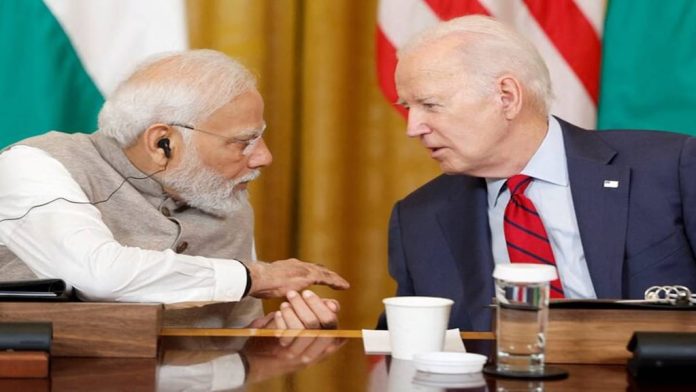By Girish Linganna
The highlight of the bilateral talks between Indian Prime Minister Narendra Modi and the US President Joe Biden in USA on September 21 was the agreement on the setting up of a semi conductor complex in Kolkata having potential of creating large number of jobs in main complex as also in ancillaries. This plant will focus on advanced sensing, communication, and power electronics for national security, next-generation telecommunications, and green energy uses..
The facility will be established with backing from the India Semiconductor Mission and a strategic technology partnership that includes Bharat Semi, 3rdiTech, and the U.S. Space Force. It will focus on manufacturing infrared, gallium nitride, and silicon carbide semiconductors.
The new manufacturing plant will be a wide bandgap compound semiconductor facility that produces GaN (gallium nitride) and SiC (silicon carbide) wafers, involving strategic partnerships.”Wide bandgap compound” refers to materials that can work efficiently at higher temperatures and voltages, like gallium nitride (GaN) and silicon carbide (SiC).
According to experts, this facility will be a plant of the future, specializing in materials beyond silicon and addressing the national security and defense needs of both the U.S. and India. Because its technology partnership includes the U.S. Air Force, this facility will be part of a very secure value chain that includes cybersecurity, setting it apart from India’s other commercial fabrication and assembly projects.
“All these developments are important for the future of the connected semiconductor supply chain that the U.S. and India share,” says Danish Faruqui, CEO of Fab Economics, as reported by Forbes India.
Along with the planned fabrication facility, the partnership will have Global Foundries (GF) set up the GF Kolkata Power Center. This will be a special hub focused on improving research and development in chip manufacturing technologies.
This initiative is likely to lead to major improvements in important areas like zero-emission vehicles, connected devices, artificial intelligence (AI), and data centres. The GF Kolkata Power Center is set to be crucial in speeding up innovations that will influence the future of these industries. Additionally, GF is looking into long-term manufacturing and technology partnerships with India.
This step will enhance technological cooperation between the two countries and create high-quality jobs in both India and the U.S., further supporting their semiconductor industries
During their bilateral discussions, Biden stated that the U.S. supports reforms in global institutions to give India a more significant voice, including making India a permanent member of the UN Security Council.
He praised PM Modi for his recent trips to Poland and Ukraine, highlighting Modi’s message of peace and humanitarian assistance for Ukraine, especially in the energy sector, as well as the importance of international law and the UN Charter, according to a White House statement.
The two leaders also talked about freedom of navigation and protecting trade, particularly in vital maritime routes in the Middle East. India is set to co-lead the Combined Task Force 150 in 2025 to collaborate with Combined Maritime Forces to secure sea lanes in the Arabian Sea.
The Prime Minister highlighted that India and the U.S. share a strong strategic partnership that encompasses many areas, driven by common democratic value shared interests, and strong connections between their people, according to a statement from the Ministry of External Affairs.
In a similar statement, the White House noted that both leaders expressed strong optimism and confidence that the efforts from their people, businesses, and governments are deepening U.S.-India ties for even greater achievements in the future.
In February of this year, the United States authorized the sale of 31 MQ-9B drones to the Indian military, with an estimated price tag of $3.99 billion (₹33,100 crores).Under the agreement, the Indian Navy will get 15 Sea Guardian drones, while the Indian Air Force and Army will each receive eight Sky Guardian drones.
President Biden praised the advancements in India’s purchase of 31 General Atomics MQ-9B drones (16 Sky Guardian and 15 Sea Guardian) along with their equipment. This deal will improve the intelligence, surveillance, and reconnaissance (ISR) abilities of India’s military in all areas, according to the joint fact sheet.
The MQ-9B Predator is recognized for its stealth capabilities, allowing it to fly as low as 250 meters (820 feet) above the ground without being noticed. The drone can reach heights of 50,000 feet and has a maximum speed of 442 km/h.
The drones are 11 meters (36 Feet) long and have a wingspan of more than 22 meters (72 Feet). It can carry a payload of approximately 1,700 kg, which includes four missiles and 450 kg of bombs, and can travel 2,000 miles (about 3,220 kilometres) without needing to refuel.
The drone can fly continuously or stay in one spot over targets for up to 35 hours, as stated by its manufacturer, General Atomics Aeronautical Systems.
PM Modi and the U.S. President also talked about the joint deal made by Lockheed Martin and Tata Advanced Systems Limited. These two companies co-chair the U.S.-India CEO Forum and collaborated on the C-130J Super Hercules aircraft.
The leaders acknowledged the significant advancements made under the U.S.-India Defense Industrial Cooperation Roadmap. This includes continuing collaboration to improve co-production efforts for jet engines, weapons, and ground mobility systems, according to the White House.
They also praised the increasing defense cooperation between the two countries through the India-U.S. Defense Acceleration Ecosystem (INDUS-X) initiative, which started in 2023.They also talked about the progress made at the third INDUS-X Summit, which took place in Silicon Valley earlier in September.
PM Modi and President Biden also praised the introduction of new technologies during the defense exercises. This includes the first-ever demonstration of the Javelin and Stryker systems in India, which took place during the ongoing YUDH ABHYAS exercise in Rajasthan. (IPA Service)


